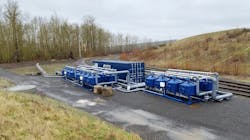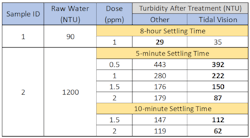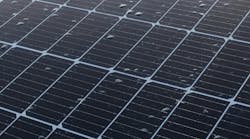A Stormwater Imperative
Stormwater runoff picks up various toxins such as motor oil, heavy metals, pesticides, lead, or other contaminants. Prior to the 1970s, such polluted stormwater flowed directly into rivers, lakes, or the ocean. Legislation, including the federal Clean Water Act, began decades of mandated regulations to treat stormwater and remove toxic elements.
Those efforts have challenged scientists, engineers, and technicians, but the battle has had measurable positive results. An important proving ground for next-generation stormwater treatment plants is currently underway in western Oregon.
Known for its many rainstorms, the state is a good place to examine new techniques and new initiatives. Much of the state’s commercial runoff occurs close to rivers and estuaries that flow into the Columbia River — an important waterway for marine life, federally protected salmon and fish habitats, tourism, and commerce.
The Efficacy of Chitosan
Clear Water Services, a leader in water treatment solutions, was established in 1998 with a mission to provide innovative construction and industrial stormwater, groundwater, and process water treatment solutions.
In the fall of 2018, Clear Water designed and installed a permanent 3,600 gallon per minute chitosan-enhanced sand filtration (CESF) system at an industrial facility in the greater Portland, Ore., area. As part of an upland source control plan, the large metal and steel facility, which discharges stormwater into a nearby surface water body listed as an EPA Superfund Site, agreed to install a water treatment system to remove sediment, heavy metals, and other contaminants prior to discharge. Clear Water’s assignment was to treat the turbidity, high pH, metals, and contaminants in runoff from the entire facility. The treatment plant has been in operation since installation.
The choice of a CESF solution was bold. Chitosan is a natural, abundant, biodegradable, and biocompatible biopolymer derived from crab shells and other shellfish. Its net positive charge binds to the negatively charged pollutants suspended in the water, essentially working like a magnet on a microscopic level to coagulate them so they can be easily filtered out. Following its use, only clarified water remains without any residual toxic chemicals.
Incorporating chitosan is not only good for the environment but also lowers operating costs, increases system flow rate capacities, and lowers Total Dissolved Solids (TDS) and turbidity (compared to traditional metal coagulants).
Because it is a biodegradable and biocompatible biopolymer, chitosan has a clear advantage over other, traditional flocculant and coagulant products used for water clarification. Traditional products are often pH-altering metal-based chemicals and/or petroleum derived polymers that are non-biodegradable and dangerous to human and animal health. As such, they end up in the wastewater sludge generated at the treatment sites. Therefore, their use requires an additional, expensive removal process.
The historic problem with chitosan use has been in the uneven manufacturing and delivery of chitosan products. In the recent past, chitosan products were not consistent batch to batch — a major problem in water treatment when precision is mandated by regulation. Where clean water is concerned, there is no such thing as close to the mark. There is only success or failure to meet regulated limits.
In the case of this treatment approach, Clear Water set up a bench-scale, pilot study to conduct a treatability assessment between two chitosan acetate products from two different vendors. At the end of the pilot study, Clear Water decided that the plant would use Tidal Clear, a product of Tidal Vision.
The Bellingham, Wash.-based company has developed a proprietary process to create water-soluble, biodegradable, and biocompatible chitosan products in the water treatment, agriculture, and textile industries. The company’s true strength is chemistry, and the company has developed processes that deliver consistent products, with no variation from one batch to the other. This chemistry acumen means the company can also personalize any order to the exact specifications of its clients.
The Clear Outcome
Numbers do not lie, and Clear Water Service’s use of Tidal Clear has been a measurable success. In the years since installation of the system and treatment improvements made possible with the Tidal Vision chitosan acetate, the facility has achieved a 93 percent average reduction in sediment and successfully addressed heavy metals contamination per permit requirements. To date, the client has remained in compliance with their Industrial Stormwater General Permit and has discharged nearly 20 million gallons of treated, effluent water well below all benchmarks. They have also seen a reduction in costs.
The Battle Joined
The fight against stormwater contamination remains a primary, vital initiative for our planet. Clear Water Services, along with Tidal Vision, have found a way to use nature, in the form of chitosan, as their solution of choice. In Oregon, the team is proving that nature is a powerful tool in the battle against stormwater contamination. SW
About the Author: Peter Moore is responsible for steering sales and marketing execution at Tidal Vision.
Published in Stormwater magazine, May 2022.



